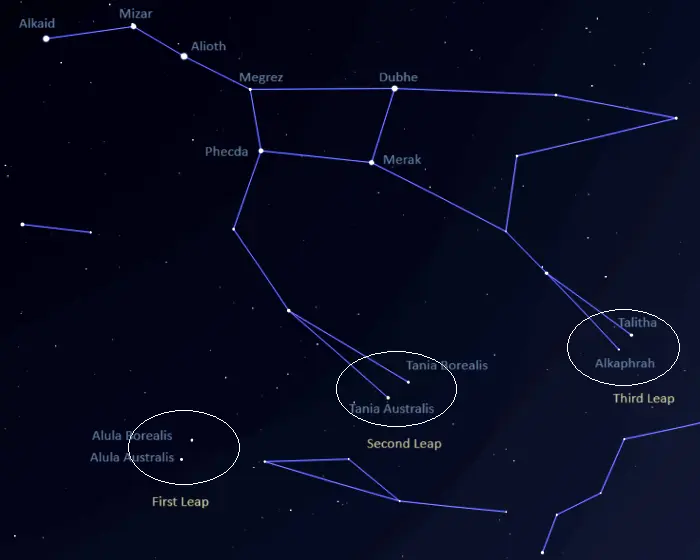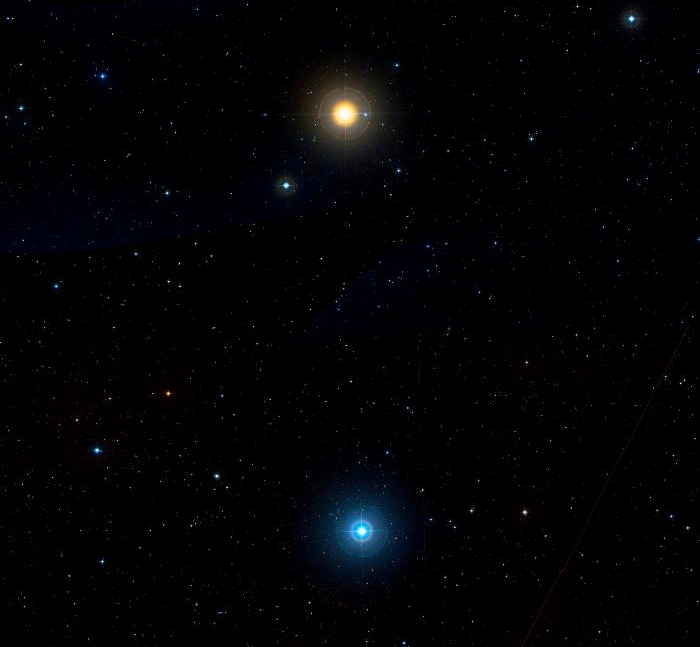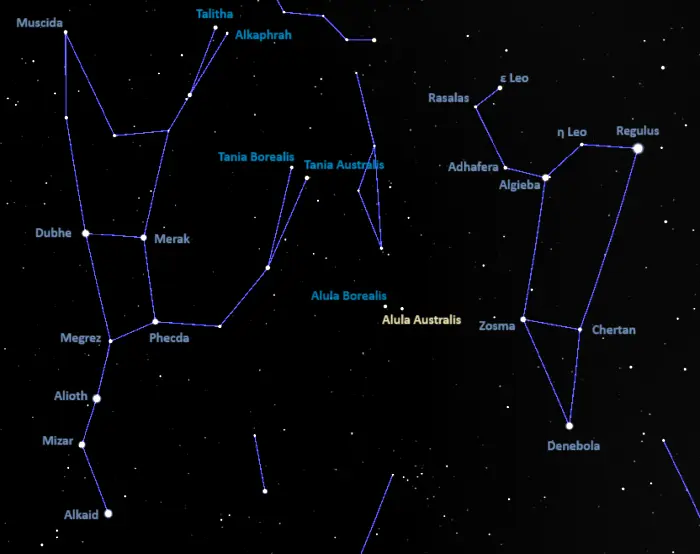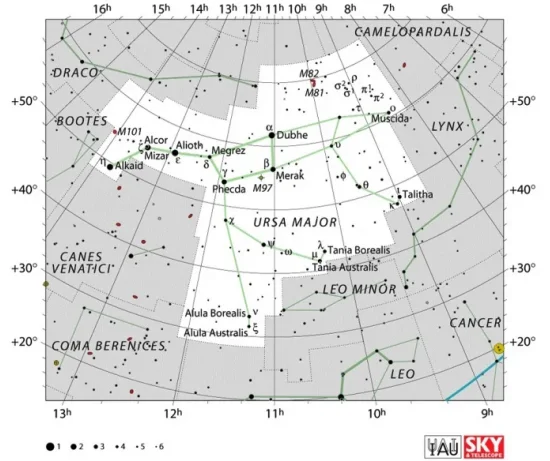Alula Australis, Xi Ursae Majoris (ξ UMa), is a multiple star system located 28.5 light-years away in the constellation Ursa Major (the Great Bear). With an apparent magnitude of 4.264, it is visible to the unaided eye. The star system is one of the six points of light that form the Three Leaps of the Gazelle, a relatively bright asterism that corresponds to the feet of the Great Bear. Alula Australis marks the Great Bear’s left hind paw.
Star system
Xi Ursae Majoris is a quadruple star system composed of two spectroscopic binary stars, designated Xi Ursae Majoris A and Xi Ursae Majoris B, and a brown dwarf discovered in 2012. The two brighter visual components have an orbital period of 59.878 years and are separated by 2.536 arcseconds in the sky, corresponding to an average physical separation of 21.2 astronomical units.
Xi Ursae Majoris A is half a magnitude brighter. It has an apparent magnitude of 4.264, while Xi Ursae Majoris B shines at magnitude 4.729.
Both Xi UMa A and Xi UMa B are single-lined spectroscopic binary stars. This means that the spectrum of only one of the stars is seen and the presence of the fainter companion can only be deduced from spectral lines periodically shifting towards the blue and then towards the red. This indicates that the primary component has an unseen companion and is orbiting around a common centre of mass.

Alula Australis (Xi Ursae Majoris), image credit: ESO/Digitized Sky Survey 2 (CC BY 4.0)
The primary component of Xi Ursae Majoris A is a yellow main sequence star of the spectral type F8.5: V. It has a mass of 0.97 solar masses and a radius of 1.02 solar radii. With an effective temperature of 6,005 K, it has a luminosity of 1.21 Suns. Xi Ursae Majoris Aa is a slow spinner, with a projected rotational velocity of 1 km/s.
The companion, Xi Ursae Majoris Ab, has only 38% of the Sun’s mass and a radius 32% that of the Sun. It has an estimated temperature of 3,700 K, indicating that it is probably a red dwarf.
The two stars are separated by only 0.057 arcseconds and take 1.832 years (669 days) to complete an orbit.
Xi Ursae Majoris Ba is a yellow dwarf of the spectral type G2 V. It has a mass of 0.86 solar masses and a radius of 0.92 solar radii. With a surface temperature of 5,692 K, it shines with 79% of the Sun’s luminosity. It spins at 3 km/s.
Xi Ursae Majoris B is classified as an RS Canum Venaticorum variable. RS CVn stars are close binary stars with active chromospheres and large starspots that cause variations in brightness, typically by 0.2 magnitudes.
The companion, Xi Ursae Majoris Bb, is likely a red dwarf. However, since the component Ba is enriched in barium, the companion may also be a white dwarf. It has an estimated mass of only 0.14 solar masses. Xi Ursae Majoris Ba and Bb have an orbital period of only 3.98 days.
The fifth component in the system, a brown dwarf with the spectral class T8.5, was discovered by Wright et al in 2012. The substellar companion was catalogued as WISE J111838.70+312537.9 in the Wide-field Infrared Survey Explorer (WISE) catalogue. It is separated by 8.5 arcminutes from the other components, corresponding to a physical separation of around 4,000 astronomical units (Earth – Sun distances).
Facts
Alula Australis forms the Three Leaps of the Gazelle with Alula Borealis (Nu Ursae Majoris), Tania Australis (Mu Ursae Majoris), Tania Borealis (Lambda Ursae Majoris), Talitha (Iota Ursae Majoris), and Alkaphrah (Kappa Ursae Majoris). The old Arabic asterism was originally known as Kafzah al Thiba’, meaning “springs of the gazelle.” It represents the leaps of a gazelle that fled across a pond when it saw a lion approaching. The celestial gazelle included the stars of what is now the constellation Leo Minor and the pond was represented by Coma Berenices.
The Three Leaps asterism consists of three pairs of stars that mark the feet of Ursa Major, the Great Bear. Alula Australis and Alula Borealis mark the first leap, Tania Australis and Tania Borealis the second leap, and Talitha and Alkaphrah the third leap. The names of the six stars refer to the Arabic names of the asterism.

Three Leaps of the Gazelle, image: Stellarium
Even though they appear close in the sky, Alula Australis and Alula Borealis are not physically related. The brighter Alula Borealis is located at a much greater distance. The evolved orange giant star lies approximately 399 light-years away.
The binary nature of Xi Ursae Majoris was discovered by the German-born English astronomer William Herschel on May 2, 1780. In 1804, after further observations, Herschel announced that the two components formed a physically connected system. Alula Australis was the first double star identified as a physically related system.
Alula Australis was also the first binary system to have its orbit calculated. In 1828, the French astronomer Félix Savary was the first to observe the visual binary star and calculate its orbit.

Alula Borealis and Alula Australis, image credit: ESO/Digitized Sky Survey 2 (CC BY 4.0)
Name
The name Alula Australis (pronunciation: /æˈluːlə ɔːˈstreɪlɪs/) is derived from the Arabic phrase Al Ḳafzah al Ūla, meaning “the first leap” or “the first spring.” It refers to the Three Leaps asterism. The word australis means “southern” or “the south side” in Latin. Alula Australis lies to the south of Alula Borealis, the other star of the First Leap of the Gazelle.
The International Astronomical Union’s (IAU) Working Group on Star Names (WGSN) approved the name on July 20, 2016. The name formally applies only to the primary component, Xi Ursae Majoris Aa.
The 15th century Timurid astronomer Ulugh Beg called Xi Ursae Majoris Al Fikrah al Ula. The German astronomer Christian Ludwig Ideler (1766 – 1846) called it Awla, and the 19th century American astronomer Elijah Hinsdale Burritt called it Acola in his The Geography Of The Heavens And Class Book Of Astronomy: Accompanied By A Celestial Atlas (1856).
In traditional Chinese astronomy, Alula Australis was known as 下台二 (Xià Tái èr), Star of Second Lower Step. It formed the Three Steps asterism with other stars of the Three Leaps of the Gazelle. The Chinese Three Steps asterism was part of the larger Supreme Palace Enclosure, which represented the imperial palace.
Location
Alula Australis and Alula Borealis appear more than halfway from Alkaid, the star at the end of the Big Dipper’s handle, to Regulus in Leo. The two stars can be found by extending a line from Chertan through Zosma in the constellation figure of the Lion. Regulus, Leo’s brightest star, can be found by drawing a line from Megrez through Phecda in the Big Dipper.
Alula Australis and Alula Borealis can be used to find the faint constellation Leo Minor (the Little Lion), which lies in the region between the feet of the Great Bear and the Sickle of Leo. Praecipua, the brightest star in Leo Minor, appears near the stars of the First Leap. It shines at magnitude 3.83 and does not stand out in the sky.
At declination +31° 31’, Alula Australis never rises from locations south of the latitude 58° S. In other words, it is visible from most inhabited locations for at least part of the year.

The location of Alula Australis (Xi Ursae Majoris), image: Stellarium
Constellation
Alula Australis is located in the constellation Ursa Major. The Great Bear is one of the ancient constellations that were catalogued by Ptolemy of Alexandria in his Almagest in the 2nd century CE. In Greek mythology, it was associated with Callisto, a nymph turned into a bear by the goddess Hera.
Ursa Major occupies an area of 1,280 square degrees of the northern sky and is the third largest of the 88 constellations, after Hydra and Virgo. It is the largest constellation in the northern celestial hemisphere.
The Great Bear is also the most recognizable northern constellation. Its seven bright stars form the Big Dipper (the Plough), a familiar asterism that never sets for northern observers. Alioth (Epsilon Ursae Majoris), the constellation’s brightest star, is an evolved A-type star that shines at magnitude 1.77 from a distance of 82.6 light-years.

Ursa Major constellation map by IAU and Sky&Telescope magazine (Roger Sinnott & Rick Fienberg) (CC BY 3.0)
Other notable stars in Ursa Major include the orange giants Dubhe (Alpha Ursae Majoris) and Psi Ursae Majoris, the hot blue main sequence star Alkaid (Eta Ursae Majoris), and the A-type stars Mizar (Zeta Ursae Majoris), Alcor (80 Ursae Majoris), Merak (Beta Ursae Majoris), Phecda (Gamma Ursae Majoris) and Megrez (Delta Ursae Majoris).
Ursa Major is also home to the red dwarf Lalande 21185, the fourth closest star system to Earth (after Alpha Centauri, Barnard’s Star and Wolf 359), the contact binary star system W Ursae Majoris, and the dwarf stars Chalawan (47 Ursae Majoris) and HIP 57274, each with three known orbiting exoplanets.
The constellation hosts many bright deep sky objects that can be observed in small and medium telescopes. The best-known ones include the Owl Nebula (Messier 97), the Pinwheel Galaxy (Messier 101), Bode’s Galaxy and the Cigar Galaxy (Messier 81 and Messier 82), and the spiral galaxies Messier 108 and Messier 109.
The best time of the year to observe the stars and deep sky objects in Ursa Major is during the month of April, when the constellation climbs higher above the horizon in the early evening. The entire constellation is visible from locations north of the latitude 30° S.
The 10 brightest stars in Ursa Major are Alioth (Epsilon UMa, mag. 1.77), Dubhe (Alpha UMa, mag. 1.79), Alkaid (Eta UMa, mag. 1.86), Mizar (Zeta UMa, mag. 2.04), Merak (Beta UMa, mag. 2.37), Phecda (Gamma UMa, 2.438), Psi Ursae Majoris (mag. 3.01), Tania Australis (Mu UMa, mag. 3.06), Talitha (Iota UMa, mag. 3.14), and Theta Ursae Majoris (mag. 3.166).
Alula Australis – Xi Ursae Majoris
| Spectral class | F8.5:V / G2V / T8.5 |
| Variable type | RS Canum Venaticorum |
| U-B colour index | 0.04 |
| B-V colour index | 0.59 |
| Distance | 28.5 ± 0.1 light-years (8.73 ± 0.03 parsecs) |
| Parallax | 114.4867 ± 0.4316 mas |
| Radial velocity | −18.2 ± 2.7 km/s |
| Proper motion | RA: −339.398 mas/yr |
| Dec.: −607.892 mas/yr | |
| Constellation | Ursa Major |
| Names and designations | Alula Australis, ξ Ursae Majoris, ξ UMa, Xi Ursae Majoris, 53 Ursae Majoris, 53 UMa, HIP 55203, SAO 62484, BD+32 2132, PLX 2625.00, GC 15537, Ci 20 627, ASCC 585912, CNS5 2767, SKY# 21520, GEN# +1.00098231, CSI+32 2132 3, 2E 2440, 2E 1115.4+3148, IRC +30229, NSV 5165, 1ES 1115+31.8, JP11 2046, N30 2652, EUVE J1118+31.5, EUVE J1118+31.4, 2EUVE J1118+31.5, UCAC3 244-100191, UCAC4 608-048190, uvby98 100098230, USNO-B1.0 1215-00188948, RX J1118.1+3130, RX J1118.1+3131, RX J1118.1+3131 1, 1RXS J111811.1+313154, YPAC 502, UBV 10288, UBV M 16962, AKARI-IRC-V1 J1118109+313147, PMSC 11128+3205, RBS 961, WISE J111810.63+313139.4, WISEA J111810.57+313139.3, RE J1118+313, RE J111810+313153, 2RE J1118+313, 2RE J111810+313143, IRAS 11154+3148, 2MASS J11181100+3131464, TD1 15519, TIC 144294174, STF 1523AB, WTE 1A, ADS 8119 AB, CCDM J11182+3132AB, IDS 11128+3206 AB, WDS J11182+3132AB |
Xi Ursae Majoris A
| Spectral class | F8.5:v |
| Apparent magnitude | 4.264 |
| Radial velocity | -26.78 ± 2.09 km/s |
| Proper motion | RA: -453.7 ± 4.4 mas/yr |
| Dec.: -591.4 ± 4.1 mas/yr | |
| Right ascension | 11h 18m 10.901164s |
| Declination | +31° 31′ 44.97910″ |
| Names and designations | Alula Australis, ξ Ursae Majoris A, ξ UMa A, Xi Ursae Majoris A, 53 Ursae Majoris A, 53 UMa A, HD 98231, HR 4375, HIP 55203A, BD+32 2132A, GJ 423 A, GJ 423 C, GCRV 6920, CSI+32 2132 1, LFT 790, LHS 2390, LTT 13045, NLTT 26920, ROT 1680, SBC7 428, SBC9 668, LSPM J1118+3131A, STF 1523A, PMSC 11128+3205A, PMSC 11128+3205Aab, WEB 9947, Zkh 153, TYC 2520-2634-1, Gaia DR2 756853643637996672, Gaia DR3 756853643638639104, ADS 8119 A, CCDM J11182+3132A, IDS 11128+3206 A, WDS J11182+3132A |
Xi Ursae Majoris Aa
| Absolute magnitude | 4.66 |
| Absolute magnitude (bolometric) | 4.54 ± 0.06 |
| Mass | 0.97 M☉ |
| Luminosity | 1.21 L☉ |
| Radius | 1.02 ± 0.04 R☉ |
| Temperature | 6,005 ± 80 K |
| Rotational velocity | 1.0 ± 1.0 km/s |
| Surface gravity | 4.39 ± 0.10 cgs |
Xi Ursae Majoris Ab
| Mass | 0.38 ± 0.02 M☉ |
| Radius | 0.32 R☉ |
| Temperature | 3,700 K |
Xi Ursae Majoris B
| Spectral class | G2V |
| Variable type | RS Canum Venaticorum (RS CVn) |
| Apparent magnitude | 4.729 |
| Parallax | 114.4867 ± 0.4316 mas |
| Radial velocity | -15.9 ± 0.9 km/s |
| Proper motion | RA: -339.398 ± 0.779 mas/yr |
| Dec.: -607.892 ± 0.764 mas/yr | |
| Right ascension | 11h 18m 10.8360115405s |
| Declination | +31° 31′ 44.821690914″ |
| Names and designations | ξ Ursae Majoris B, ξ UMa B, Xi Ursae Majoris B, 53 Ursae Majoris B, 53 UMa B, HD 98230, HR 4374, HIP 55203B, BD+32 2132B, GJ 423 B, GJ 423 D, GCRV 6921, LFT 791, LHS 2391, LTT 13046, NLTT 26921, LSPM J1118+3131B, CHR 178, Zkh 154, CSI+32 2132 2, PMSC 11128+3205B, PMSC 11128+3205Bab, ROT 1679, SBC7 427, SBC9 667, CABS 92, CCABS 76, WEB 9945, WEB 9946, UBV M 16961, STF 1523B, TYC 2520-2634-2, Gaia DR2 756853643637996160, Gaia DR3 756853643637996160, ADS 8119 B, CCDM J11182+3132B, IDS 11128+3206 B, WDS J11182+3132B, WDS J11182+3132Ba,Bb |
Xi Ursae Majoris Ba
| Absolute magnitude | 5.16 |
| Absolute magnitude (bolometric) | 5.00 ± 0.06 |
| Mass | 0.86 M☉ |
| Luminosity | 0.79 L☉ |
| Radius | 0.92 ± 0.04 R☉ |
| Temperature | 5,692 ± 90 K |
| Metallicity | −0.35 ± 0.08 dex |
| Rotational velocity | 3.0 ± 1.0 km/s |
| Surface gravity | 4.46 ± 0.10 cgs |
Xi Ursae Majoris Bb
| Mass | 0.14 M☉ (0.05 – 0.19 M☉) |
WISE J1118+3125
| Spectral class | T8.5 |
| Proper motion | RA: -78.2 ± 10.5 mas/yr |
| Dec.: -512.7 ± 10.6 mas/yr | |
| Right ascension | 11h 18m 38.70096s |
| Declination | +31° 25′ 37.9200” |
| Names and designations | ξ Ursae Majoris C, ξ UMa C, Xi Ursae Majoris C, WISE J1118+3125, WISE J111838.70+312537.9, WISEA J111838.69+312537.7, GJ 423 E, CNS5 2771, WDS J11182+3132D, WTE 1D |